Housing Team Transformation: A Comprehensive Change Management Report
VerifiedAdded on 2023/06/16
|16
|5372
|300
Report
AI Summary
This report provides a detailed analysis of change management strategies employed during a housing team transformation project. It begins by evaluating existing change management techniques and highlighting key weaknesses, emphasizing the importance of understanding success from the customer's perspective and involving employees at all levels. The report outlines a project plan that includes determining work sequence, defining work tasks, and resource breakdown, suggesting an ADKAR structured format for implementation. It identifies main issues such as functionalized work design and the use of trailing metrics, which led to a focus on the wrong areas and disappointing outcomes. The ADKAR and Prosci models are discussed as frameworks for guiding the change process, focusing on awareness, desire, knowledge, ability, and reinforcement. The report underscores the significance of addressing potential resistance, providing concrete examples, and benchmarking studies to demonstrate the impact of effective change management.
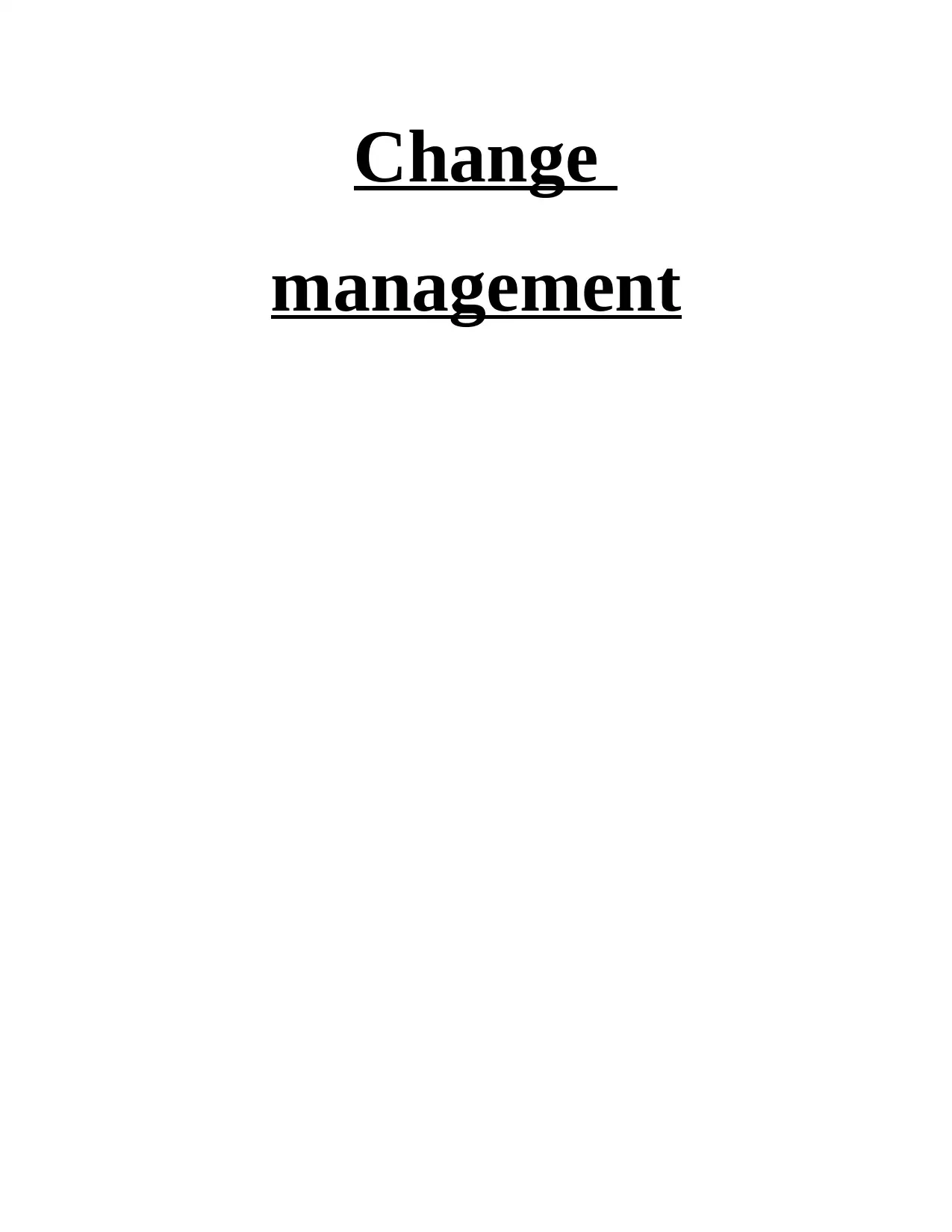
Change
management
management
Secure Best Marks with AI Grader
Need help grading? Try our AI Grader for instant feedback on your assignments.
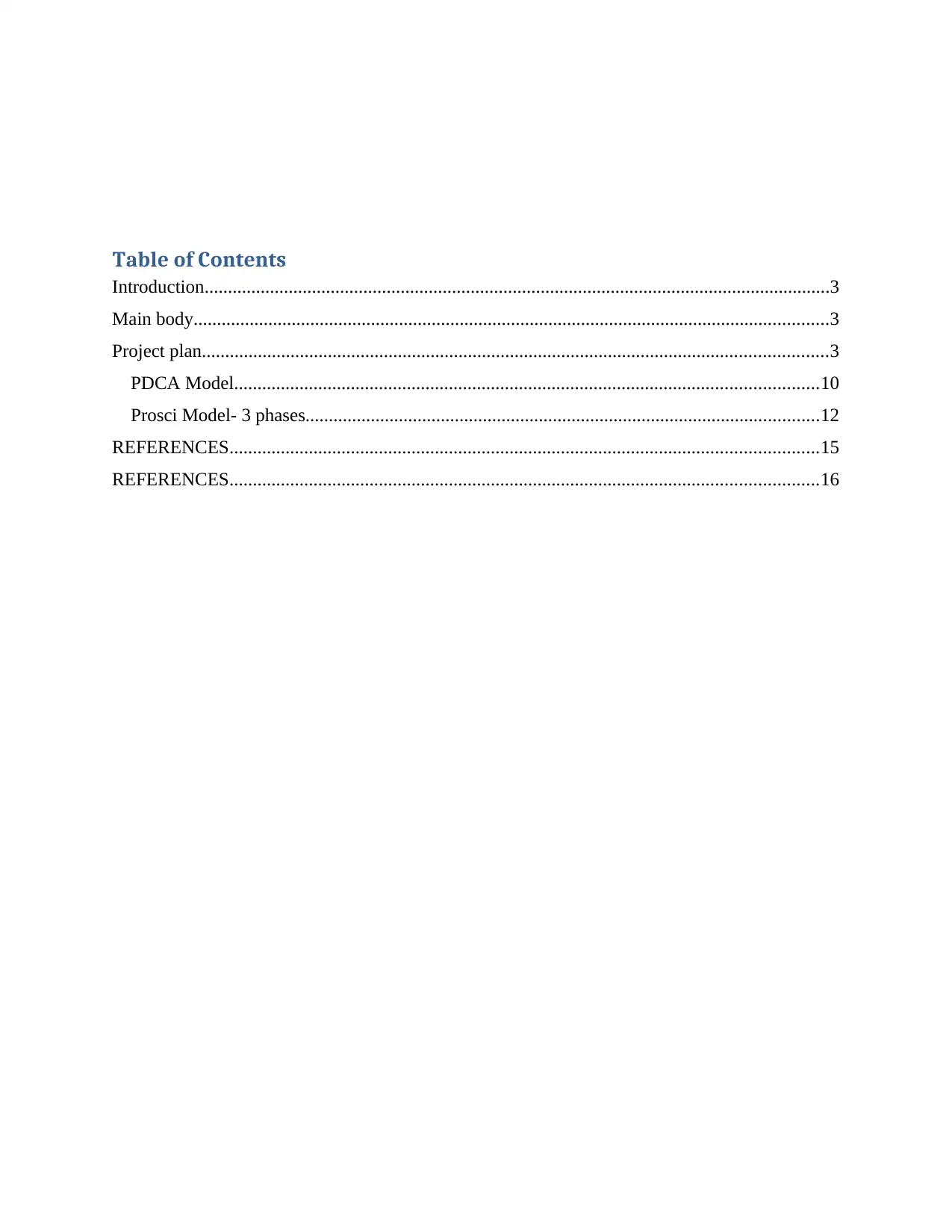
Table of Contents
Introduction......................................................................................................................................3
Main body........................................................................................................................................3
Project plan......................................................................................................................................3
PDCA Model.............................................................................................................................10
Prosci Model- 3 phases..............................................................................................................12
REFERENCES..............................................................................................................................15
REFERENCES..............................................................................................................................16
Introduction......................................................................................................................................3
Main body........................................................................................................................................3
Project plan......................................................................................................................................3
PDCA Model.............................................................................................................................10
Prosci Model- 3 phases..............................................................................................................12
REFERENCES..............................................................................................................................15
REFERENCES..............................................................................................................................16
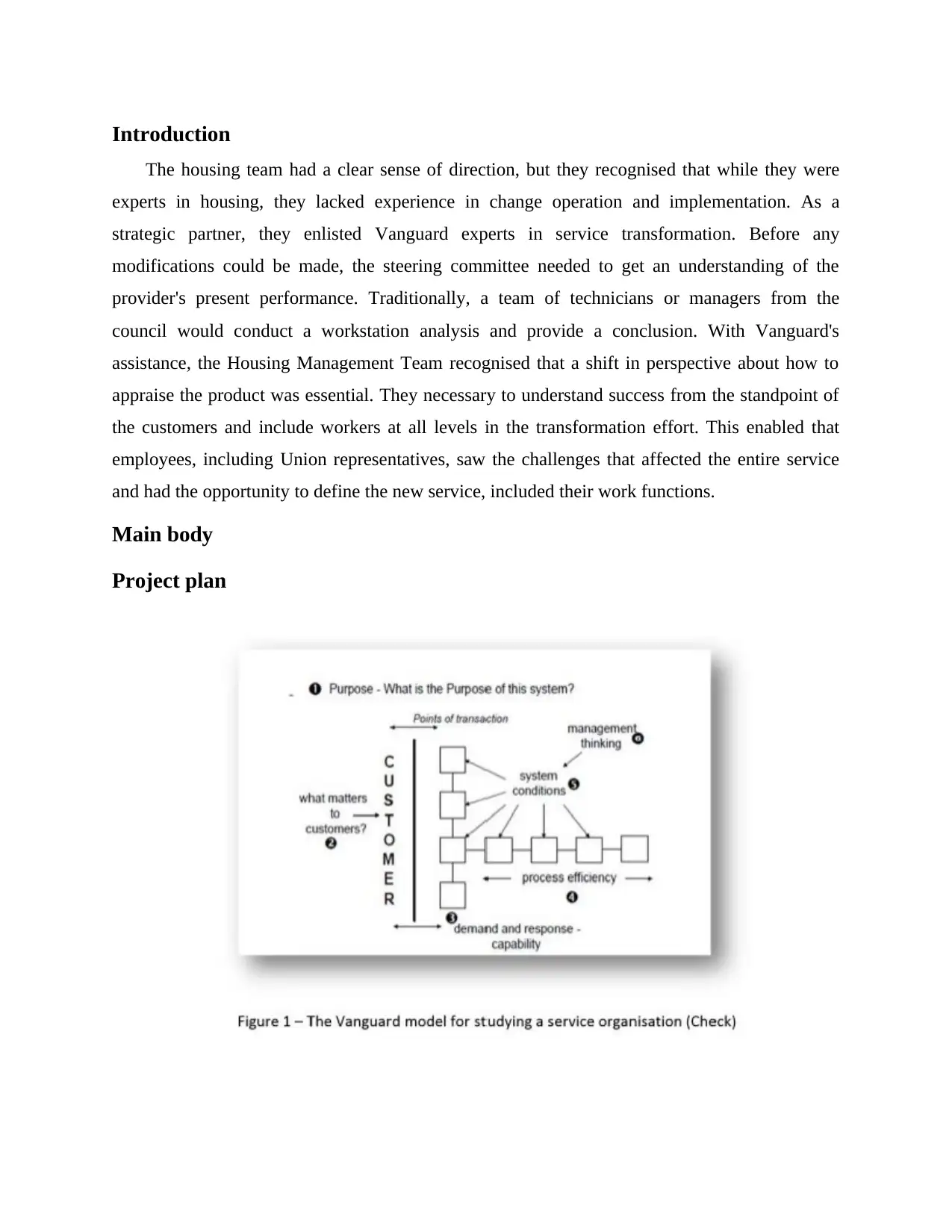
Introduction
The housing team had a clear sense of direction, but they recognised that while they were
experts in housing, they lacked experience in change operation and implementation. As a
strategic partner, they enlisted Vanguard experts in service transformation. Before any
modifications could be made, the steering committee needed to get an understanding of the
provider's present performance. Traditionally, a team of technicians or managers from the
council would conduct a workstation analysis and provide a conclusion. With Vanguard's
assistance, the Housing Management Team recognised that a shift in perspective about how to
appraise the product was essential. They necessary to understand success from the standpoint of
the customers and include workers at all levels in the transformation effort. This enabled that
employees, including Union representatives, saw the challenges that affected the entire service
and had the opportunity to define the new service, included their work functions.
Main body
Project plan
The housing team had a clear sense of direction, but they recognised that while they were
experts in housing, they lacked experience in change operation and implementation. As a
strategic partner, they enlisted Vanguard experts in service transformation. Before any
modifications could be made, the steering committee needed to get an understanding of the
provider's present performance. Traditionally, a team of technicians or managers from the
council would conduct a workstation analysis and provide a conclusion. With Vanguard's
assistance, the Housing Management Team recognised that a shift in perspective about how to
appraise the product was essential. They necessary to understand success from the standpoint of
the customers and include workers at all levels in the transformation effort. This enabled that
employees, including Union representatives, saw the challenges that affected the entire service
and had the opportunity to define the new service, included their work functions.
Main body
Project plan
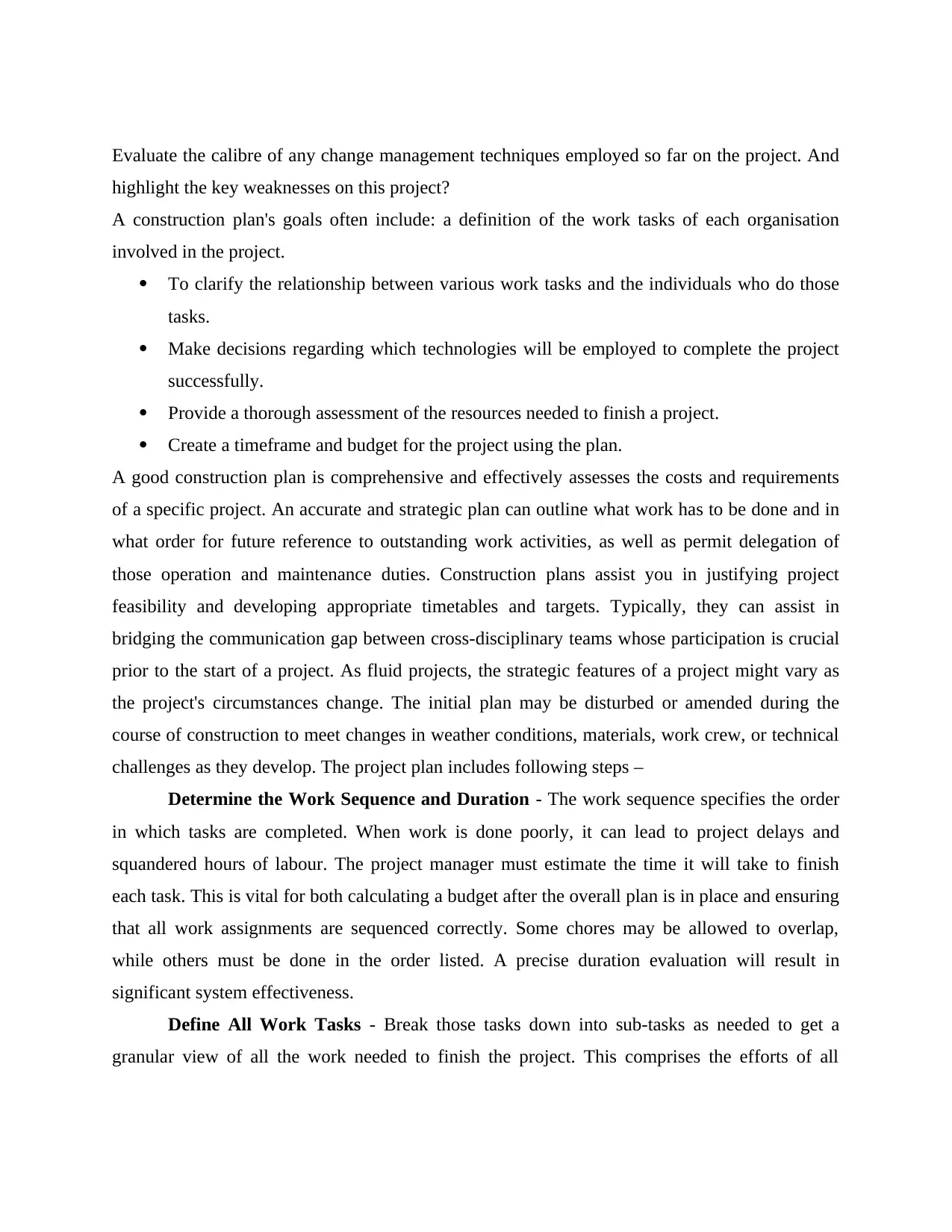
Evaluate the calibre of any change management techniques employed so far on the project. And
highlight the key weaknesses on this project?
A construction plan's goals often include: a definition of the work tasks of each organisation
involved in the project.
To clarify the relationship between various work tasks and the individuals who do those
tasks.
Make decisions regarding which technologies will be employed to complete the project
successfully.
Provide a thorough assessment of the resources needed to finish a project.
Create a timeframe and budget for the project using the plan.
A good construction plan is comprehensive and effectively assesses the costs and requirements
of a specific project. An accurate and strategic plan can outline what work has to be done and in
what order for future reference to outstanding work activities, as well as permit delegation of
those operation and maintenance duties. Construction plans assist you in justifying project
feasibility and developing appropriate timetables and targets. Typically, they can assist in
bridging the communication gap between cross-disciplinary teams whose participation is crucial
prior to the start of a project. As fluid projects, the strategic features of a project might vary as
the project's circumstances change. The initial plan may be disturbed or amended during the
course of construction to meet changes in weather conditions, materials, work crew, or technical
challenges as they develop. The project plan includes following steps –
Determine the Work Sequence and Duration - The work sequence specifies the order
in which tasks are completed. When work is done poorly, it can lead to project delays and
squandered hours of labour. The project manager must estimate the time it will take to finish
each task. This is vital for both calculating a budget after the overall plan is in place and ensuring
that all work assignments are sequenced correctly. Some chores may be allowed to overlap,
while others must be done in the order listed. A precise duration evaluation will result in
significant system effectiveness.
Define All Work Tasks - Break those tasks down into sub-tasks as needed to get a
granular view of all the work needed to finish the project. This comprises the efforts of all
highlight the key weaknesses on this project?
A construction plan's goals often include: a definition of the work tasks of each organisation
involved in the project.
To clarify the relationship between various work tasks and the individuals who do those
tasks.
Make decisions regarding which technologies will be employed to complete the project
successfully.
Provide a thorough assessment of the resources needed to finish a project.
Create a timeframe and budget for the project using the plan.
A good construction plan is comprehensive and effectively assesses the costs and requirements
of a specific project. An accurate and strategic plan can outline what work has to be done and in
what order for future reference to outstanding work activities, as well as permit delegation of
those operation and maintenance duties. Construction plans assist you in justifying project
feasibility and developing appropriate timetables and targets. Typically, they can assist in
bridging the communication gap between cross-disciplinary teams whose participation is crucial
prior to the start of a project. As fluid projects, the strategic features of a project might vary as
the project's circumstances change. The initial plan may be disturbed or amended during the
course of construction to meet changes in weather conditions, materials, work crew, or technical
challenges as they develop. The project plan includes following steps –
Determine the Work Sequence and Duration - The work sequence specifies the order
in which tasks are completed. When work is done poorly, it can lead to project delays and
squandered hours of labour. The project manager must estimate the time it will take to finish
each task. This is vital for both calculating a budget after the overall plan is in place and ensuring
that all work assignments are sequenced correctly. Some chores may be allowed to overlap,
while others must be done in the order listed. A precise duration evaluation will result in
significant system effectiveness.
Define All Work Tasks - Break those tasks down into sub-tasks as needed to get a
granular view of all the work needed to finish the project. This comprises the efforts of all
Secure Best Marks with AI Grader
Need help grading? Try our AI Grader for instant feedback on your assignments.
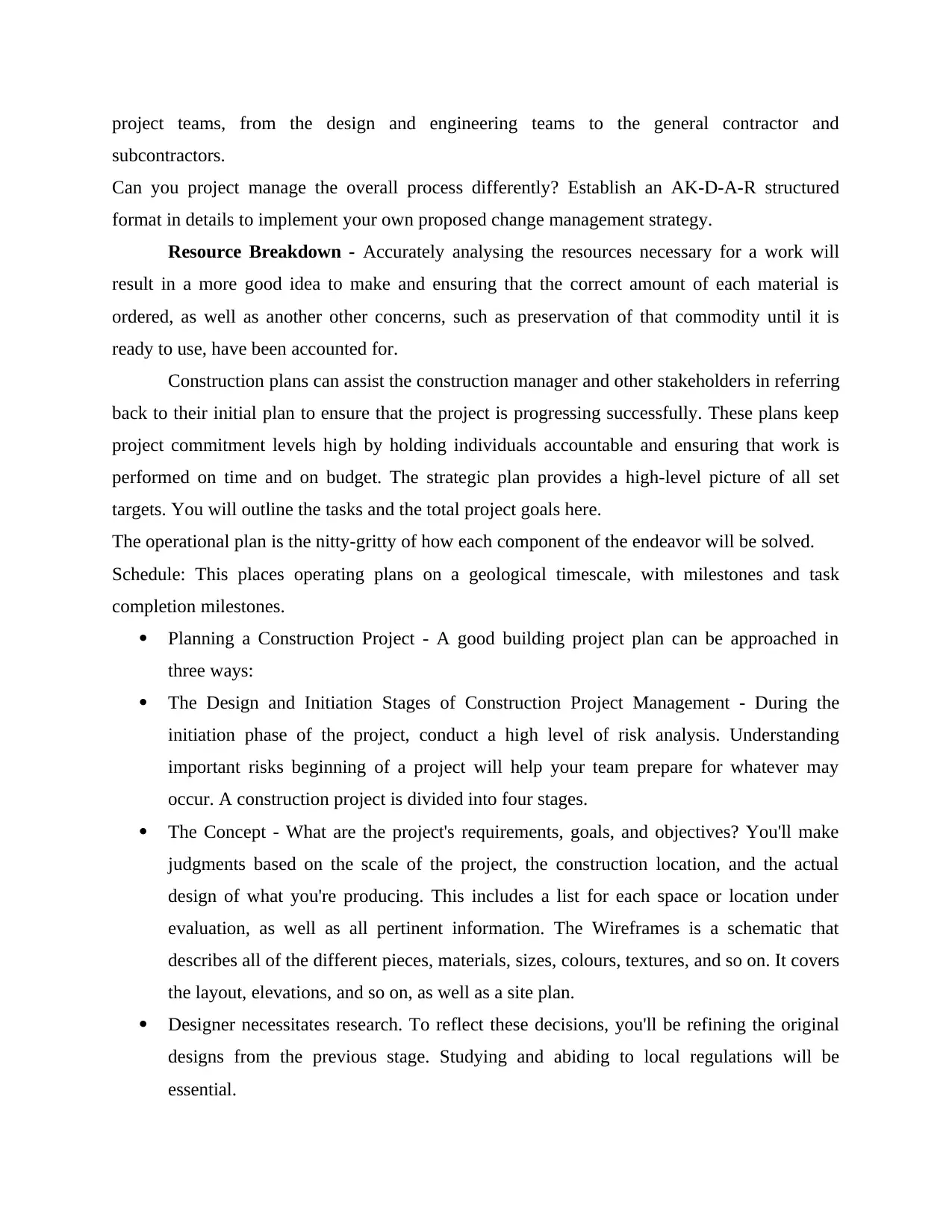
project teams, from the design and engineering teams to the general contractor and
subcontractors.
Can you project manage the overall process differently? Establish an AK-D-A-R structured
format in details to implement your own proposed change management strategy.
Resource Breakdown - Accurately analysing the resources necessary for a work will
result in a more good idea to make and ensuring that the correct amount of each material is
ordered, as well as another other concerns, such as preservation of that commodity until it is
ready to use, have been accounted for.
Construction plans can assist the construction manager and other stakeholders in referring
back to their initial plan to ensure that the project is progressing successfully. These plans keep
project commitment levels high by holding individuals accountable and ensuring that work is
performed on time and on budget. The strategic plan provides a high-level picture of all set
targets. You will outline the tasks and the total project goals here.
The operational plan is the nitty-gritty of how each component of the endeavor will be solved.
Schedule: This places operating plans on a geological timescale, with milestones and task
completion milestones.
Planning a Construction Project - A good building project plan can be approached in
three ways:
The Design and Initiation Stages of Construction Project Management - During the
initiation phase of the project, conduct a high level of risk analysis. Understanding
important risks beginning of a project will help your team prepare for whatever may
occur. A construction project is divided into four stages.
The Concept - What are the project's requirements, goals, and objectives? You'll make
judgments based on the scale of the project, the construction location, and the actual
design of what you're producing. This includes a list for each space or location under
evaluation, as well as all pertinent information. The Wireframes is a schematic that
describes all of the different pieces, materials, sizes, colours, textures, and so on. It covers
the layout, elevations, and so on, as well as a site plan.
Designer necessitates research. To reflect these decisions, you'll be refining the original
designs from the previous stage. Studying and abiding to local regulations will be
essential.
subcontractors.
Can you project manage the overall process differently? Establish an AK-D-A-R structured
format in details to implement your own proposed change management strategy.
Resource Breakdown - Accurately analysing the resources necessary for a work will
result in a more good idea to make and ensuring that the correct amount of each material is
ordered, as well as another other concerns, such as preservation of that commodity until it is
ready to use, have been accounted for.
Construction plans can assist the construction manager and other stakeholders in referring
back to their initial plan to ensure that the project is progressing successfully. These plans keep
project commitment levels high by holding individuals accountable and ensuring that work is
performed on time and on budget. The strategic plan provides a high-level picture of all set
targets. You will outline the tasks and the total project goals here.
The operational plan is the nitty-gritty of how each component of the endeavor will be solved.
Schedule: This places operating plans on a geological timescale, with milestones and task
completion milestones.
Planning a Construction Project - A good building project plan can be approached in
three ways:
The Design and Initiation Stages of Construction Project Management - During the
initiation phase of the project, conduct a high level of risk analysis. Understanding
important risks beginning of a project will help your team prepare for whatever may
occur. A construction project is divided into four stages.
The Concept - What are the project's requirements, goals, and objectives? You'll make
judgments based on the scale of the project, the construction location, and the actual
design of what you're producing. This includes a list for each space or location under
evaluation, as well as all pertinent information. The Wireframes is a schematic that
describes all of the different pieces, materials, sizes, colours, textures, and so on. It covers
the layout, elevations, and so on, as well as a site plan.
Designer necessitates research. To reflect these decisions, you'll be refining the original
designs from the previous stage. Studying and abiding to local regulations will be
essential.
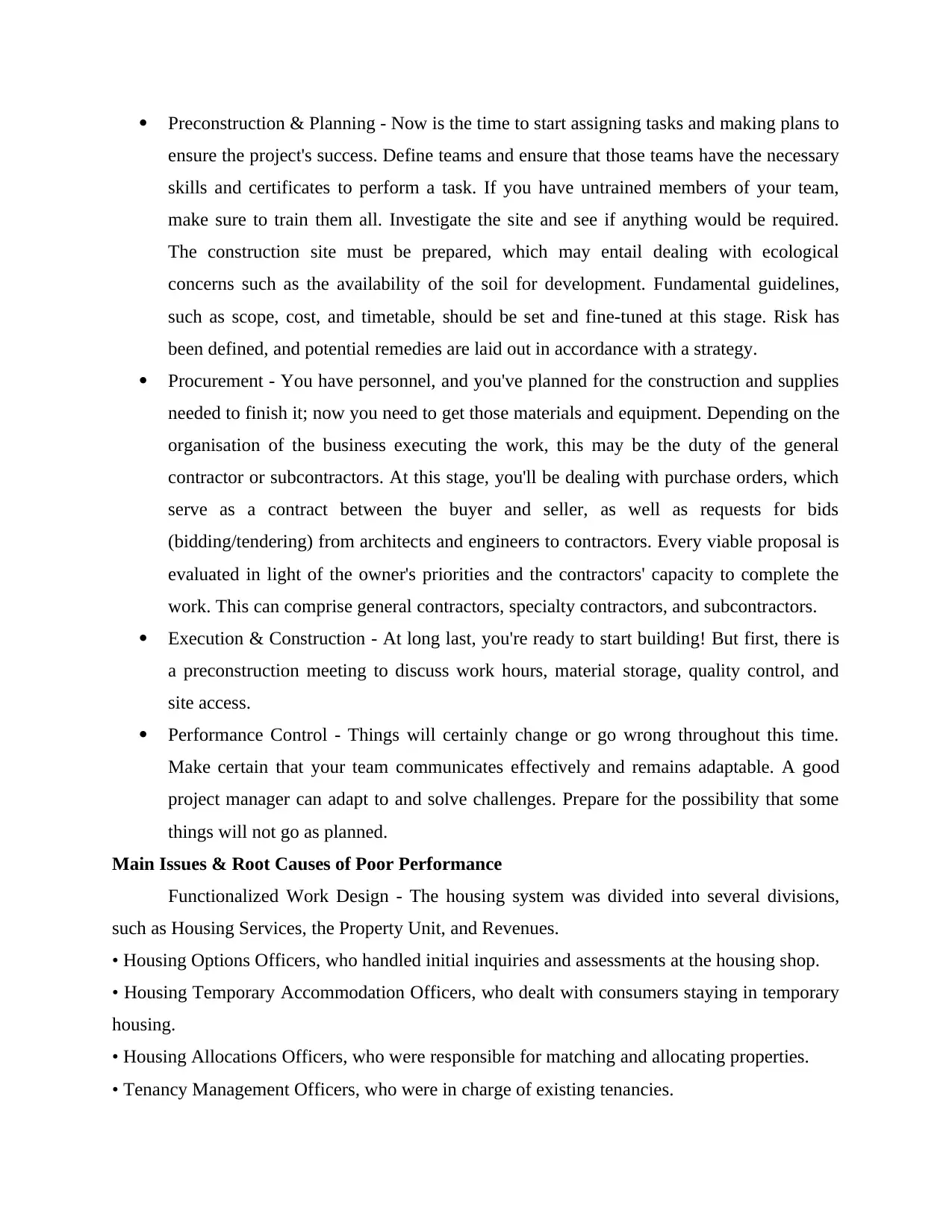
Preconstruction & Planning - Now is the time to start assigning tasks and making plans to
ensure the project's success. Define teams and ensure that those teams have the necessary
skills and certificates to perform a task. If you have untrained members of your team,
make sure to train them all. Investigate the site and see if anything would be required.
The construction site must be prepared, which may entail dealing with ecological
concerns such as the availability of the soil for development. Fundamental guidelines,
such as scope, cost, and timetable, should be set and fine-tuned at this stage. Risk has
been defined, and potential remedies are laid out in accordance with a strategy.
Procurement - You have personnel, and you've planned for the construction and supplies
needed to finish it; now you need to get those materials and equipment. Depending on the
organisation of the business executing the work, this may be the duty of the general
contractor or subcontractors. At this stage, you'll be dealing with purchase orders, which
serve as a contract between the buyer and seller, as well as requests for bids
(bidding/tendering) from architects and engineers to contractors. Every viable proposal is
evaluated in light of the owner's priorities and the contractors' capacity to complete the
work. This can comprise general contractors, specialty contractors, and subcontractors.
Execution & Construction - At long last, you're ready to start building! But first, there is
a preconstruction meeting to discuss work hours, material storage, quality control, and
site access.
Performance Control - Things will certainly change or go wrong throughout this time.
Make certain that your team communicates effectively and remains adaptable. A good
project manager can adapt to and solve challenges. Prepare for the possibility that some
things will not go as planned.
Main Issues & Root Causes of Poor Performance
Functionalized Work Design - The housing system was divided into several divisions,
such as Housing Services, the Property Unit, and Revenues.
• Housing Options Officers, who handled initial inquiries and assessments at the housing shop.
• Housing Temporary Accommodation Officers, who dealt with consumers staying in temporary
housing.
• Housing Allocations Officers, who were responsible for matching and allocating properties.
• Tenancy Management Officers, who were in charge of existing tenancies.
ensure the project's success. Define teams and ensure that those teams have the necessary
skills and certificates to perform a task. If you have untrained members of your team,
make sure to train them all. Investigate the site and see if anything would be required.
The construction site must be prepared, which may entail dealing with ecological
concerns such as the availability of the soil for development. Fundamental guidelines,
such as scope, cost, and timetable, should be set and fine-tuned at this stage. Risk has
been defined, and potential remedies are laid out in accordance with a strategy.
Procurement - You have personnel, and you've planned for the construction and supplies
needed to finish it; now you need to get those materials and equipment. Depending on the
organisation of the business executing the work, this may be the duty of the general
contractor or subcontractors. At this stage, you'll be dealing with purchase orders, which
serve as a contract between the buyer and seller, as well as requests for bids
(bidding/tendering) from architects and engineers to contractors. Every viable proposal is
evaluated in light of the owner's priorities and the contractors' capacity to complete the
work. This can comprise general contractors, specialty contractors, and subcontractors.
Execution & Construction - At long last, you're ready to start building! But first, there is
a preconstruction meeting to discuss work hours, material storage, quality control, and
site access.
Performance Control - Things will certainly change or go wrong throughout this time.
Make certain that your team communicates effectively and remains adaptable. A good
project manager can adapt to and solve challenges. Prepare for the possibility that some
things will not go as planned.
Main Issues & Root Causes of Poor Performance
Functionalized Work Design - The housing system was divided into several divisions,
such as Housing Services, the Property Unit, and Revenues.
• Housing Options Officers, who handled initial inquiries and assessments at the housing shop.
• Housing Temporary Accommodation Officers, who dealt with consumers staying in temporary
housing.
• Housing Allocations Officers, who were responsible for matching and allocating properties.
• Tenancy Management Officers, who were in charge of existing tenancies.
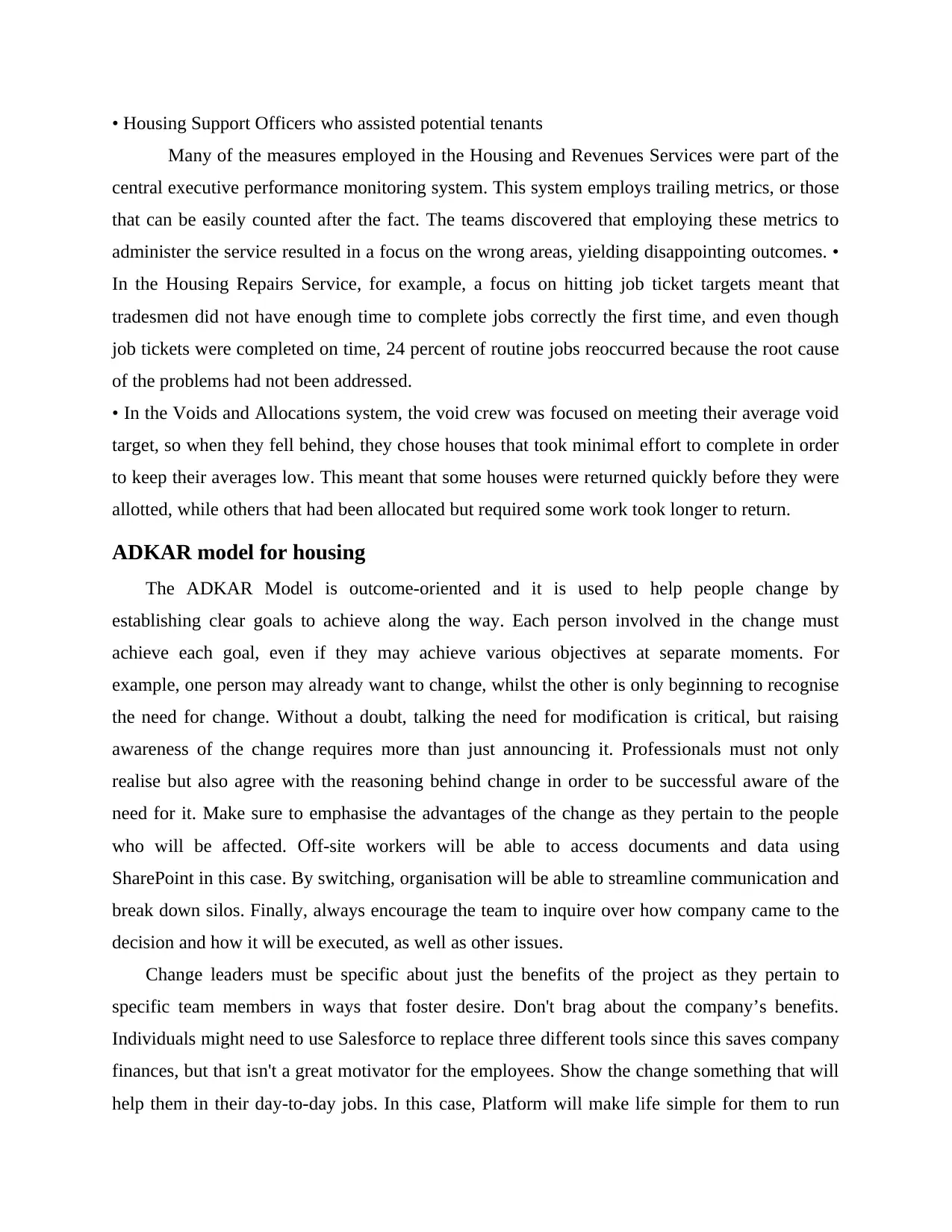
• Housing Support Officers who assisted potential tenants
Many of the measures employed in the Housing and Revenues Services were part of the
central executive performance monitoring system. This system employs trailing metrics, or those
that can be easily counted after the fact. The teams discovered that employing these metrics to
administer the service resulted in a focus on the wrong areas, yielding disappointing outcomes. •
In the Housing Repairs Service, for example, a focus on hitting job ticket targets meant that
tradesmen did not have enough time to complete jobs correctly the first time, and even though
job tickets were completed on time, 24 percent of routine jobs reoccurred because the root cause
of the problems had not been addressed.
• In the Voids and Allocations system, the void crew was focused on meeting their average void
target, so when they fell behind, they chose houses that took minimal effort to complete in order
to keep their averages low. This meant that some houses were returned quickly before they were
allotted, while others that had been allocated but required some work took longer to return.
ADKAR model for housing
The ADKAR Model is outcome-oriented and it is used to help people change by
establishing clear goals to achieve along the way. Each person involved in the change must
achieve each goal, even if they may achieve various objectives at separate moments. For
example, one person may already want to change, whilst the other is only beginning to recognise
the need for change. Without a doubt, talking the need for modification is critical, but raising
awareness of the change requires more than just announcing it. Professionals must not only
realise but also agree with the reasoning behind change in order to be successful aware of the
need for it. Make sure to emphasise the advantages of the change as they pertain to the people
who will be affected. Off-site workers will be able to access documents and data using
SharePoint in this case. By switching, organisation will be able to streamline communication and
break down silos. Finally, always encourage the team to inquire over how company came to the
decision and how it will be executed, as well as other issues.
Change leaders must be specific about just the benefits of the project as they pertain to
specific team members in ways that foster desire. Don't brag about the company’s benefits.
Individuals might need to use Salesforce to replace three different tools since this saves company
finances, but that isn't a great motivator for the employees. Show the change something that will
help them in their day-to-day jobs. In this case, Platform will make life simple for them to run
Many of the measures employed in the Housing and Revenues Services were part of the
central executive performance monitoring system. This system employs trailing metrics, or those
that can be easily counted after the fact. The teams discovered that employing these metrics to
administer the service resulted in a focus on the wrong areas, yielding disappointing outcomes. •
In the Housing Repairs Service, for example, a focus on hitting job ticket targets meant that
tradesmen did not have enough time to complete jobs correctly the first time, and even though
job tickets were completed on time, 24 percent of routine jobs reoccurred because the root cause
of the problems had not been addressed.
• In the Voids and Allocations system, the void crew was focused on meeting their average void
target, so when they fell behind, they chose houses that took minimal effort to complete in order
to keep their averages low. This meant that some houses were returned quickly before they were
allotted, while others that had been allocated but required some work took longer to return.
ADKAR model for housing
The ADKAR Model is outcome-oriented and it is used to help people change by
establishing clear goals to achieve along the way. Each person involved in the change must
achieve each goal, even if they may achieve various objectives at separate moments. For
example, one person may already want to change, whilst the other is only beginning to recognise
the need for change. Without a doubt, talking the need for modification is critical, but raising
awareness of the change requires more than just announcing it. Professionals must not only
realise but also agree with the reasoning behind change in order to be successful aware of the
need for it. Make sure to emphasise the advantages of the change as they pertain to the people
who will be affected. Off-site workers will be able to access documents and data using
SharePoint in this case. By switching, organisation will be able to streamline communication and
break down silos. Finally, always encourage the team to inquire over how company came to the
decision and how it will be executed, as well as other issues.
Change leaders must be specific about just the benefits of the project as they pertain to
specific team members in ways that foster desire. Don't brag about the company’s benefits.
Individuals might need to use Salesforce to replace three different tools since this saves company
finances, but that isn't a great motivator for the employees. Show the change something that will
help them in their day-to-day jobs. In this case, Platform will make life simple for them to run
Paraphrase This Document
Need a fresh take? Get an instant paraphrase of this document with our AI Paraphraser
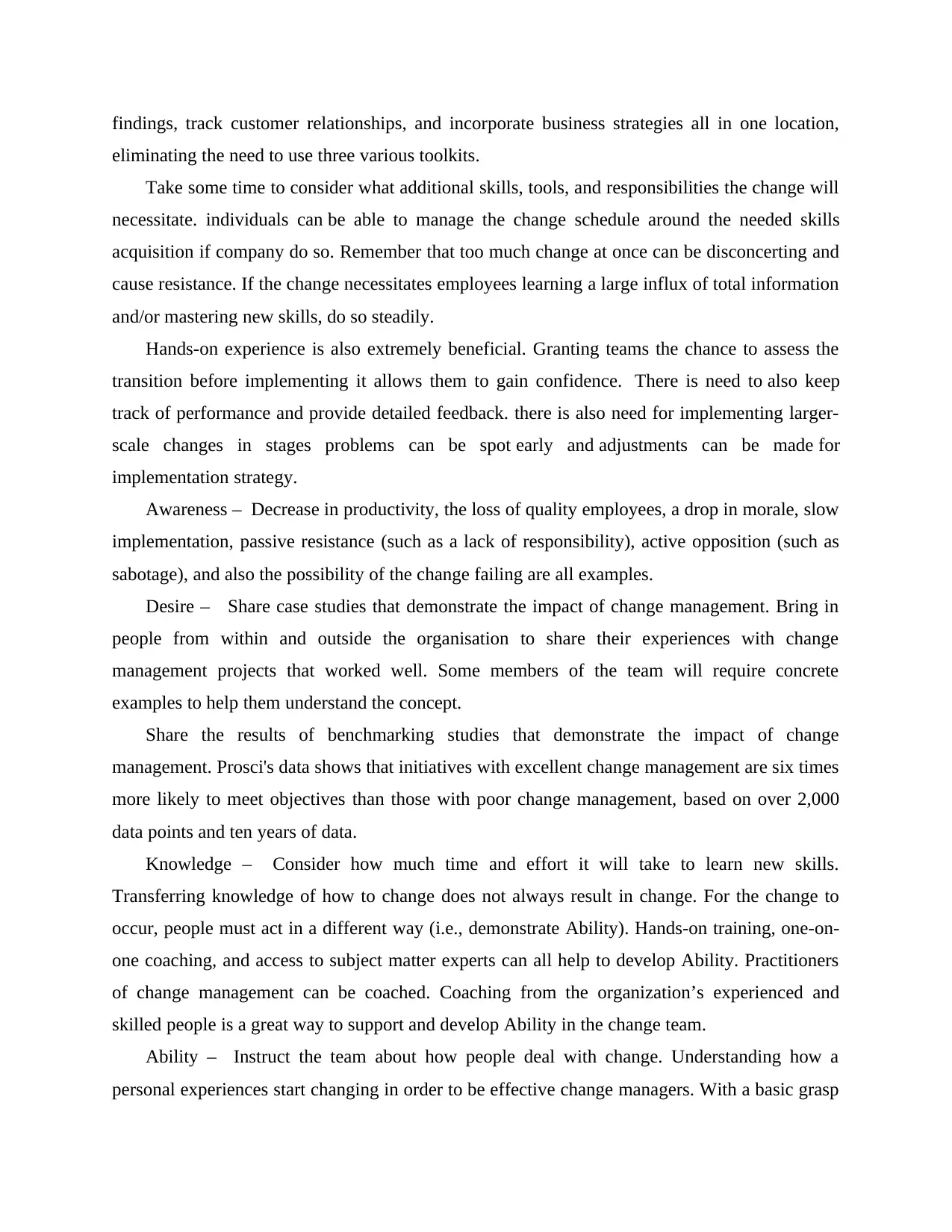
findings, track customer relationships, and incorporate business strategies all in one location,
eliminating the need to use three various toolkits.
Take some time to consider what additional skills, tools, and responsibilities the change will
necessitate. individuals can be able to manage the change schedule around the needed skills
acquisition if company do so. Remember that too much change at once can be disconcerting and
cause resistance. If the change necessitates employees learning a large influx of total information
and/or mastering new skills, do so steadily.
Hands-on experience is also extremely beneficial. Granting teams the chance to assess the
transition before implementing it allows them to gain confidence. There is need to also keep
track of performance and provide detailed feedback. there is also need for implementing larger-
scale changes in stages problems can be spot early and adjustments can be made for
implementation strategy.
Awareness – Decrease in productivity, the loss of quality employees, a drop in morale, slow
implementation, passive resistance (such as a lack of responsibility), active opposition (such as
sabotage), and also the possibility of the change failing are all examples.
Desire – Share case studies that demonstrate the impact of change management. Bring in
people from within and outside the organisation to share their experiences with change
management projects that worked well. Some members of the team will require concrete
examples to help them understand the concept.
Share the results of benchmarking studies that demonstrate the impact of change
management. Prosci's data shows that initiatives with excellent change management are six times
more likely to meet objectives than those with poor change management, based on over 2,000
data points and ten years of data.
Knowledge – Consider how much time and effort it will take to learn new skills.
Transferring knowledge of how to change does not always result in change. For the change to
occur, people must act in a different way (i.e., demonstrate Ability). Hands-on training, one-on-
one coaching, and access to subject matter experts can all help to develop Ability. Practitioners
of change management can be coached. Coaching from the organization’s experienced and
skilled people is a great way to support and develop Ability in the change team.
Ability – Instruct the team about how people deal with change. Understanding how a
personal experiences start changing in order to be effective change managers. With a basic grasp
eliminating the need to use three various toolkits.
Take some time to consider what additional skills, tools, and responsibilities the change will
necessitate. individuals can be able to manage the change schedule around the needed skills
acquisition if company do so. Remember that too much change at once can be disconcerting and
cause resistance. If the change necessitates employees learning a large influx of total information
and/or mastering new skills, do so steadily.
Hands-on experience is also extremely beneficial. Granting teams the chance to assess the
transition before implementing it allows them to gain confidence. There is need to also keep
track of performance and provide detailed feedback. there is also need for implementing larger-
scale changes in stages problems can be spot early and adjustments can be made for
implementation strategy.
Awareness – Decrease in productivity, the loss of quality employees, a drop in morale, slow
implementation, passive resistance (such as a lack of responsibility), active opposition (such as
sabotage), and also the possibility of the change failing are all examples.
Desire – Share case studies that demonstrate the impact of change management. Bring in
people from within and outside the organisation to share their experiences with change
management projects that worked well. Some members of the team will require concrete
examples to help them understand the concept.
Share the results of benchmarking studies that demonstrate the impact of change
management. Prosci's data shows that initiatives with excellent change management are six times
more likely to meet objectives than those with poor change management, based on over 2,000
data points and ten years of data.
Knowledge – Consider how much time and effort it will take to learn new skills.
Transferring knowledge of how to change does not always result in change. For the change to
occur, people must act in a different way (i.e., demonstrate Ability). Hands-on training, one-on-
one coaching, and access to subject matter experts can all help to develop Ability. Practitioners
of change management can be coached. Coaching from the organization’s experienced and
skilled people is a great way to support and develop Ability in the change team.
Ability – Instruct the team about how people deal with change. Understanding how a
personal experiences start changing in order to be effective change managers. With a basic grasp
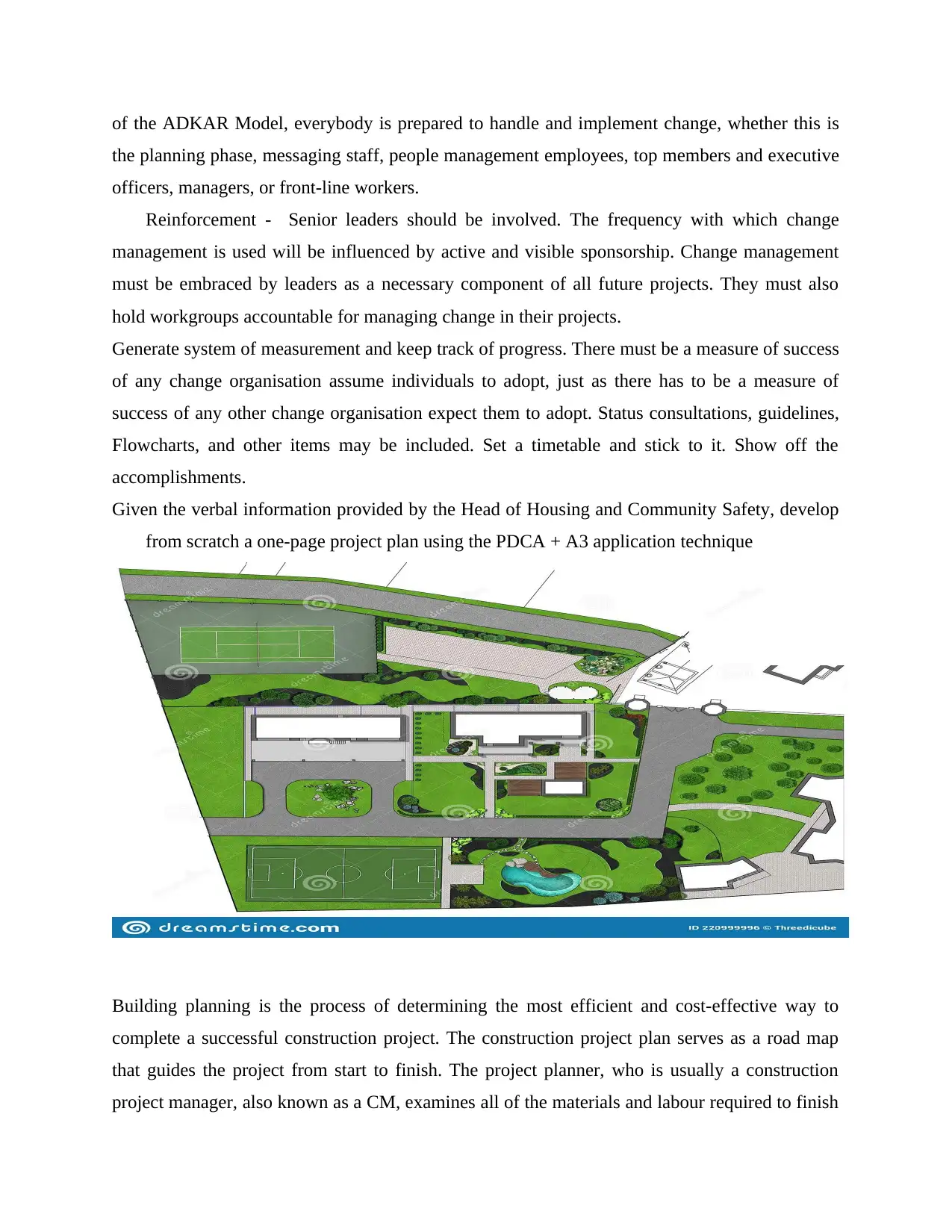
of the ADKAR Model, everybody is prepared to handle and implement change, whether this is
the planning phase, messaging staff, people management employees, top members and executive
officers, managers, or front-line workers.
Reinforcement - Senior leaders should be involved. The frequency with which change
management is used will be influenced by active and visible sponsorship. Change management
must be embraced by leaders as a necessary component of all future projects. They must also
hold workgroups accountable for managing change in their projects.
Generate system of measurement and keep track of progress. There must be a measure of success
of any change organisation assume individuals to adopt, just as there has to be a measure of
success of any other change organisation expect them to adopt. Status consultations, guidelines,
Flowcharts, and other items may be included. Set a timetable and stick to it. Show off the
accomplishments.
Given the verbal information provided by the Head of Housing and Community Safety, develop
from scratch a one-page project plan using the PDCA + A3 application technique
Building planning is the process of determining the most efficient and cost-effective way to
complete a successful construction project. The construction project plan serves as a road map
that guides the project from start to finish. The project planner, who is usually a construction
project manager, also known as a CM, examines all of the materials and labour required to finish
the planning phase, messaging staff, people management employees, top members and executive
officers, managers, or front-line workers.
Reinforcement - Senior leaders should be involved. The frequency with which change
management is used will be influenced by active and visible sponsorship. Change management
must be embraced by leaders as a necessary component of all future projects. They must also
hold workgroups accountable for managing change in their projects.
Generate system of measurement and keep track of progress. There must be a measure of success
of any change organisation assume individuals to adopt, just as there has to be a measure of
success of any other change organisation expect them to adopt. Status consultations, guidelines,
Flowcharts, and other items may be included. Set a timetable and stick to it. Show off the
accomplishments.
Given the verbal information provided by the Head of Housing and Community Safety, develop
from scratch a one-page project plan using the PDCA + A3 application technique
Building planning is the process of determining the most efficient and cost-effective way to
complete a successful construction project. The construction project plan serves as a road map
that guides the project from start to finish. The project planner, who is usually a construction
project manager, also known as a CM, examines all of the materials and labour required to finish
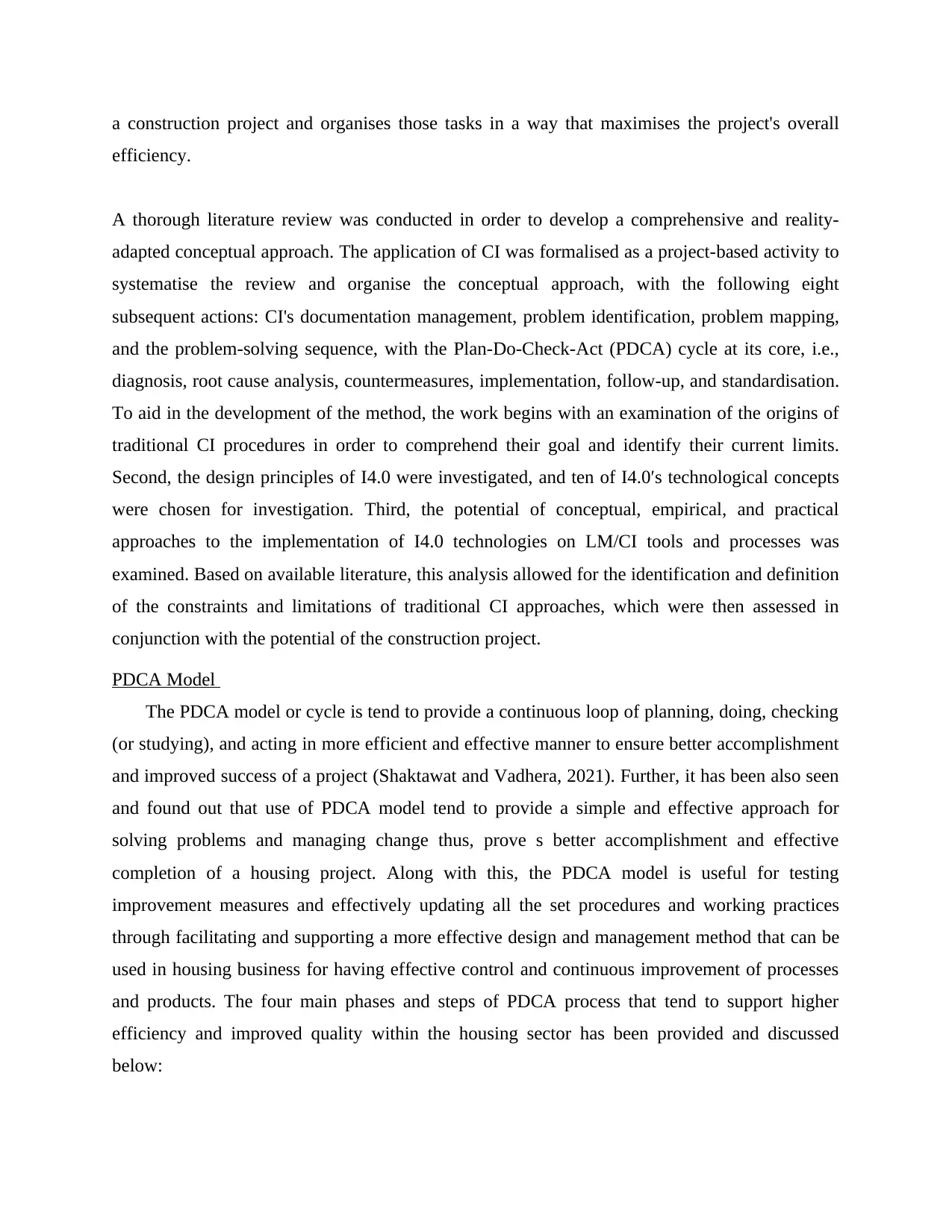
a construction project and organises those tasks in a way that maximises the project's overall
efficiency.
A thorough literature review was conducted in order to develop a comprehensive and reality-
adapted conceptual approach. The application of CI was formalised as a project-based activity to
systematise the review and organise the conceptual approach, with the following eight
subsequent actions: CI's documentation management, problem identification, problem mapping,
and the problem-solving sequence, with the Plan-Do-Check-Act (PDCA) cycle at its core, i.e.,
diagnosis, root cause analysis, countermeasures, implementation, follow-up, and standardisation.
To aid in the development of the method, the work begins with an examination of the origins of
traditional CI procedures in order to comprehend their goal and identify their current limits.
Second, the design principles of I4.0 were investigated, and ten of I4.0′s technological concepts
were chosen for investigation. Third, the potential of conceptual, empirical, and practical
approaches to the implementation of I4.0 technologies on LM/CI tools and processes was
examined. Based on available literature, this analysis allowed for the identification and definition
of the constraints and limitations of traditional CI approaches, which were then assessed in
conjunction with the potential of the construction project.
PDCA Model
The PDCA model or cycle is tend to provide a continuous loop of planning, doing, checking
(or studying), and acting in more efficient and effective manner to ensure better accomplishment
and improved success of a project (Shaktawat and Vadhera, 2021). Further, it has been also seen
and found out that use of PDCA model tend to provide a simple and effective approach for
solving problems and managing change thus, prove s better accomplishment and effective
completion of a housing project. Along with this, the PDCA model is useful for testing
improvement measures and effectively updating all the set procedures and working practices
through facilitating and supporting a more effective design and management method that can be
used in housing business for having effective control and continuous improvement of processes
and products. The four main phases and steps of PDCA process that tend to support higher
efficiency and improved quality within the housing sector has been provided and discussed
below:
efficiency.
A thorough literature review was conducted in order to develop a comprehensive and reality-
adapted conceptual approach. The application of CI was formalised as a project-based activity to
systematise the review and organise the conceptual approach, with the following eight
subsequent actions: CI's documentation management, problem identification, problem mapping,
and the problem-solving sequence, with the Plan-Do-Check-Act (PDCA) cycle at its core, i.e.,
diagnosis, root cause analysis, countermeasures, implementation, follow-up, and standardisation.
To aid in the development of the method, the work begins with an examination of the origins of
traditional CI procedures in order to comprehend their goal and identify their current limits.
Second, the design principles of I4.0 were investigated, and ten of I4.0′s technological concepts
were chosen for investigation. Third, the potential of conceptual, empirical, and practical
approaches to the implementation of I4.0 technologies on LM/CI tools and processes was
examined. Based on available literature, this analysis allowed for the identification and definition
of the constraints and limitations of traditional CI approaches, which were then assessed in
conjunction with the potential of the construction project.
PDCA Model
The PDCA model or cycle is tend to provide a continuous loop of planning, doing, checking
(or studying), and acting in more efficient and effective manner to ensure better accomplishment
and improved success of a project (Shaktawat and Vadhera, 2021). Further, it has been also seen
and found out that use of PDCA model tend to provide a simple and effective approach for
solving problems and managing change thus, prove s better accomplishment and effective
completion of a housing project. Along with this, the PDCA model is useful for testing
improvement measures and effectively updating all the set procedures and working practices
through facilitating and supporting a more effective design and management method that can be
used in housing business for having effective control and continuous improvement of processes
and products. The four main phases and steps of PDCA process that tend to support higher
efficiency and improved quality within the housing sector has been provided and discussed
below:
Secure Best Marks with AI Grader
Need help grading? Try our AI Grader for instant feedback on your assignments.
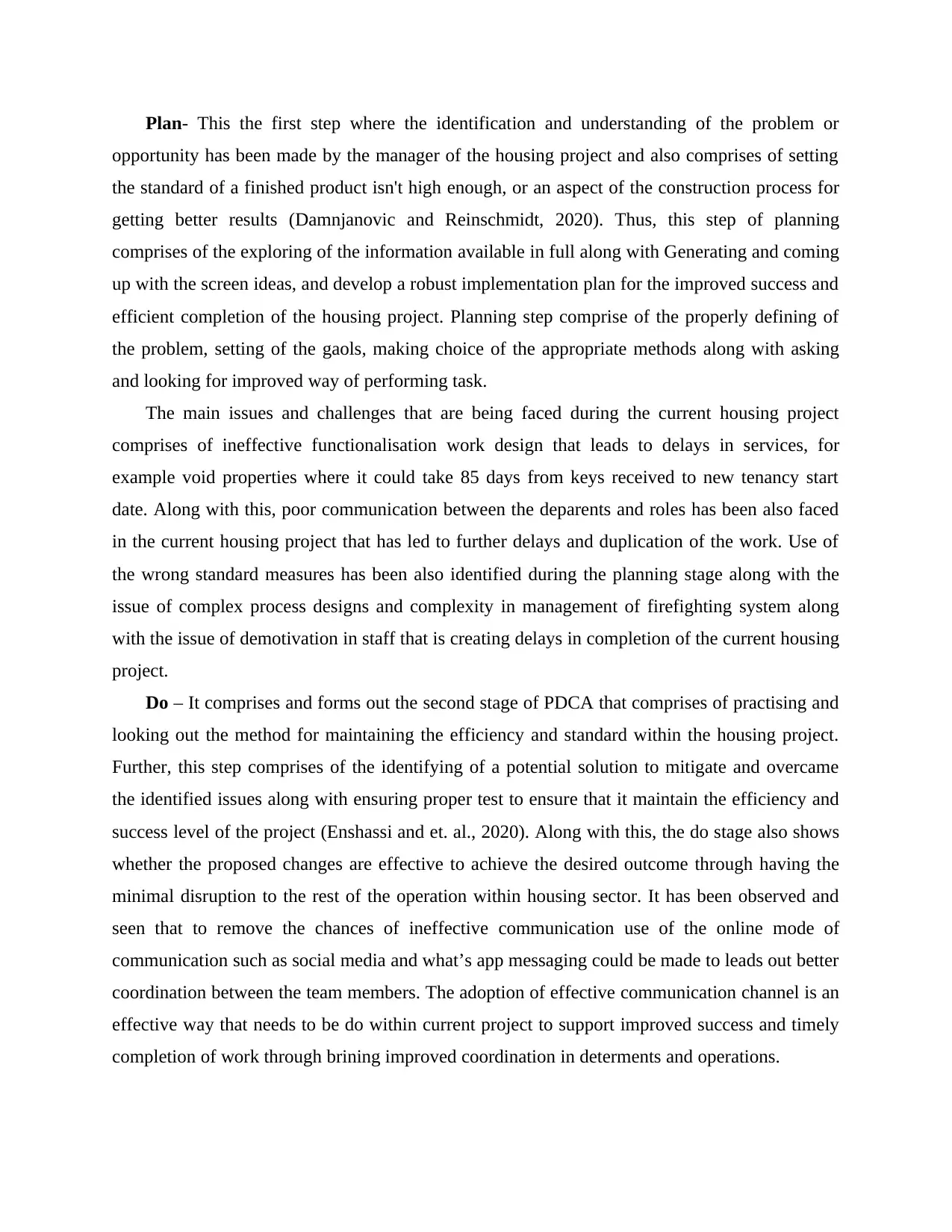
Plan- This the first step where the identification and understanding of the problem or
opportunity has been made by the manager of the housing project and also comprises of setting
the standard of a finished product isn't high enough, or an aspect of the construction process for
getting better results (Damnjanovic and Reinschmidt, 2020). Thus, this step of planning
comprises of the exploring of the information available in full along with Generating and coming
up with the screen ideas, and develop a robust implementation plan for the improved success and
efficient completion of the housing project. Planning step comprise of the properly defining of
the problem, setting of the gaols, making choice of the appropriate methods along with asking
and looking for improved way of performing task.
The main issues and challenges that are being faced during the current housing project
comprises of ineffective functionalisation work design that leads to delays in services, for
example void properties where it could take 85 days from keys received to new tenancy start
date. Along with this, poor communication between the deparents and roles has been also faced
in the current housing project that has led to further delays and duplication of the work. Use of
the wrong standard measures has been also identified during the planning stage along with the
issue of complex process designs and complexity in management of firefighting system along
with the issue of demotivation in staff that is creating delays in completion of the current housing
project.
Do – It comprises and forms out the second stage of PDCA that comprises of practising and
looking out the method for maintaining the efficiency and standard within the housing project.
Further, this step comprises of the identifying of a potential solution to mitigate and overcame
the identified issues along with ensuring proper test to ensure that it maintain the efficiency and
success level of the project (Enshassi and et. al., 2020). Along with this, the do stage also shows
whether the proposed changes are effective to achieve the desired outcome through having the
minimal disruption to the rest of the operation within housing sector. It has been observed and
seen that to remove the chances of ineffective communication use of the online mode of
communication such as social media and what’s app messaging could be made to leads out better
coordination between the team members. The adoption of effective communication channel is an
effective way that needs to be do within current project to support improved success and timely
completion of work through brining improved coordination in determents and operations.
opportunity has been made by the manager of the housing project and also comprises of setting
the standard of a finished product isn't high enough, or an aspect of the construction process for
getting better results (Damnjanovic and Reinschmidt, 2020). Thus, this step of planning
comprises of the exploring of the information available in full along with Generating and coming
up with the screen ideas, and develop a robust implementation plan for the improved success and
efficient completion of the housing project. Planning step comprise of the properly defining of
the problem, setting of the gaols, making choice of the appropriate methods along with asking
and looking for improved way of performing task.
The main issues and challenges that are being faced during the current housing project
comprises of ineffective functionalisation work design that leads to delays in services, for
example void properties where it could take 85 days from keys received to new tenancy start
date. Along with this, poor communication between the deparents and roles has been also faced
in the current housing project that has led to further delays and duplication of the work. Use of
the wrong standard measures has been also identified during the planning stage along with the
issue of complex process designs and complexity in management of firefighting system along
with the issue of demotivation in staff that is creating delays in completion of the current housing
project.
Do – It comprises and forms out the second stage of PDCA that comprises of practising and
looking out the method for maintaining the efficiency and standard within the housing project.
Further, this step comprises of the identifying of a potential solution to mitigate and overcame
the identified issues along with ensuring proper test to ensure that it maintain the efficiency and
success level of the project (Enshassi and et. al., 2020). Along with this, the do stage also shows
whether the proposed changes are effective to achieve the desired outcome through having the
minimal disruption to the rest of the operation within housing sector. It has been observed and
seen that to remove the chances of ineffective communication use of the online mode of
communication such as social media and what’s app messaging could be made to leads out better
coordination between the team members. The adoption of effective communication channel is an
effective way that needs to be do within current project to support improved success and timely
completion of work through brining improved coordination in determents and operations.
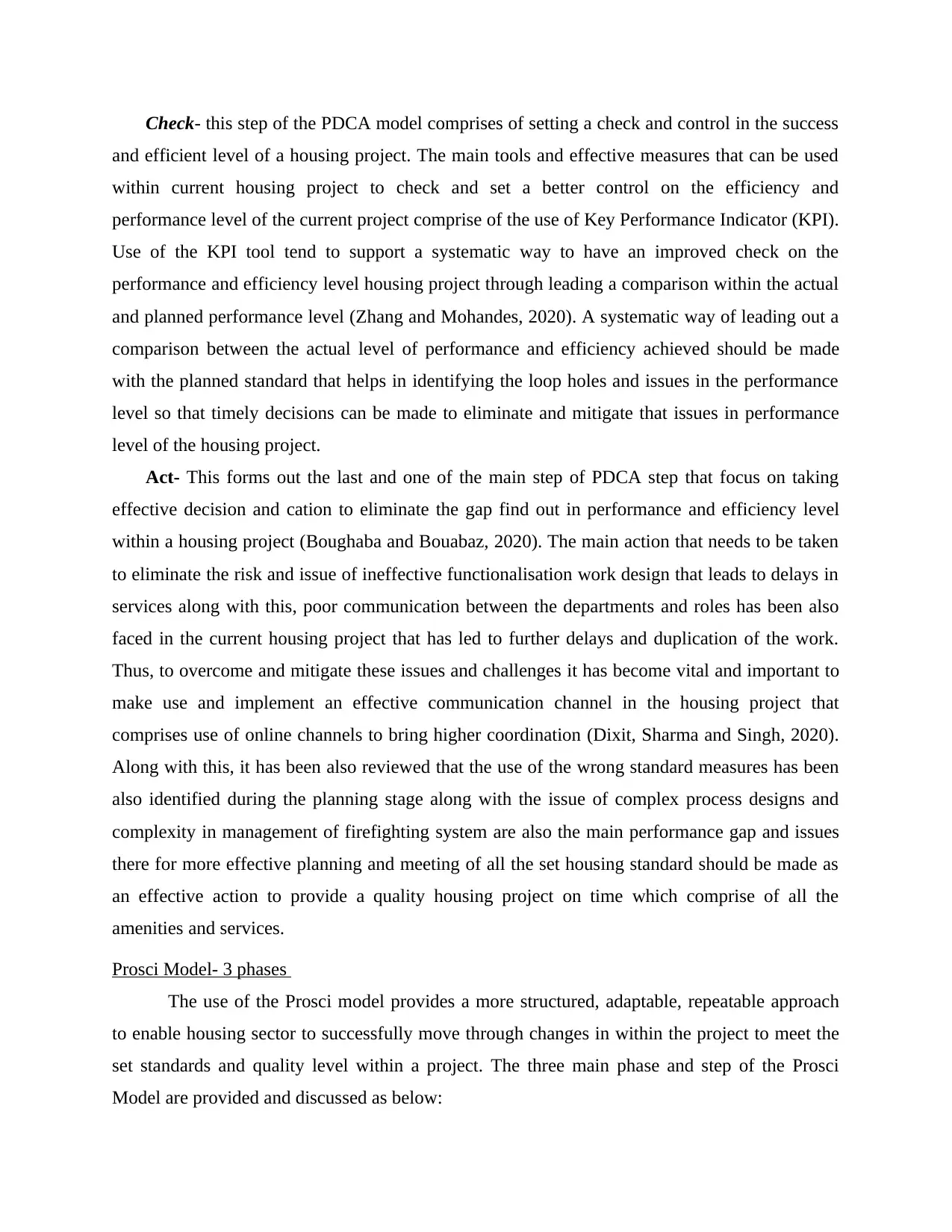
Check- this step of the PDCA model comprises of setting a check and control in the success
and efficient level of a housing project. The main tools and effective measures that can be used
within current housing project to check and set a better control on the efficiency and
performance level of the current project comprise of the use of Key Performance Indicator (KPI).
Use of the KPI tool tend to support a systematic way to have an improved check on the
performance and efficiency level housing project through leading a comparison within the actual
and planned performance level (Zhang and Mohandes, 2020). A systematic way of leading out a
comparison between the actual level of performance and efficiency achieved should be made
with the planned standard that helps in identifying the loop holes and issues in the performance
level so that timely decisions can be made to eliminate and mitigate that issues in performance
level of the housing project.
Act- This forms out the last and one of the main step of PDCA step that focus on taking
effective decision and cation to eliminate the gap find out in performance and efficiency level
within a housing project (Boughaba and Bouabaz, 2020). The main action that needs to be taken
to eliminate the risk and issue of ineffective functionalisation work design that leads to delays in
services along with this, poor communication between the departments and roles has been also
faced in the current housing project that has led to further delays and duplication of the work.
Thus, to overcome and mitigate these issues and challenges it has become vital and important to
make use and implement an effective communication channel in the housing project that
comprises use of online channels to bring higher coordination (Dixit, Sharma and Singh, 2020).
Along with this, it has been also reviewed that the use of the wrong standard measures has been
also identified during the planning stage along with the issue of complex process designs and
complexity in management of firefighting system are also the main performance gap and issues
there for more effective planning and meeting of all the set housing standard should be made as
an effective action to provide a quality housing project on time which comprise of all the
amenities and services.
Prosci Model- 3 phases
The use of the Prosci model provides a more structured, adaptable, repeatable approach
to enable housing sector to successfully move through changes in within the project to meet the
set standards and quality level within a project. The three main phase and step of the Prosci
Model are provided and discussed as below:
and efficient level of a housing project. The main tools and effective measures that can be used
within current housing project to check and set a better control on the efficiency and
performance level of the current project comprise of the use of Key Performance Indicator (KPI).
Use of the KPI tool tend to support a systematic way to have an improved check on the
performance and efficiency level housing project through leading a comparison within the actual
and planned performance level (Zhang and Mohandes, 2020). A systematic way of leading out a
comparison between the actual level of performance and efficiency achieved should be made
with the planned standard that helps in identifying the loop holes and issues in the performance
level so that timely decisions can be made to eliminate and mitigate that issues in performance
level of the housing project.
Act- This forms out the last and one of the main step of PDCA step that focus on taking
effective decision and cation to eliminate the gap find out in performance and efficiency level
within a housing project (Boughaba and Bouabaz, 2020). The main action that needs to be taken
to eliminate the risk and issue of ineffective functionalisation work design that leads to delays in
services along with this, poor communication between the departments and roles has been also
faced in the current housing project that has led to further delays and duplication of the work.
Thus, to overcome and mitigate these issues and challenges it has become vital and important to
make use and implement an effective communication channel in the housing project that
comprises use of online channels to bring higher coordination (Dixit, Sharma and Singh, 2020).
Along with this, it has been also reviewed that the use of the wrong standard measures has been
also identified during the planning stage along with the issue of complex process designs and
complexity in management of firefighting system are also the main performance gap and issues
there for more effective planning and meeting of all the set housing standard should be made as
an effective action to provide a quality housing project on time which comprise of all the
amenities and services.
Prosci Model- 3 phases
The use of the Prosci model provides a more structured, adaptable, repeatable approach
to enable housing sector to successfully move through changes in within the project to meet the
set standards and quality level within a project. The three main phase and step of the Prosci
Model are provided and discussed as below:
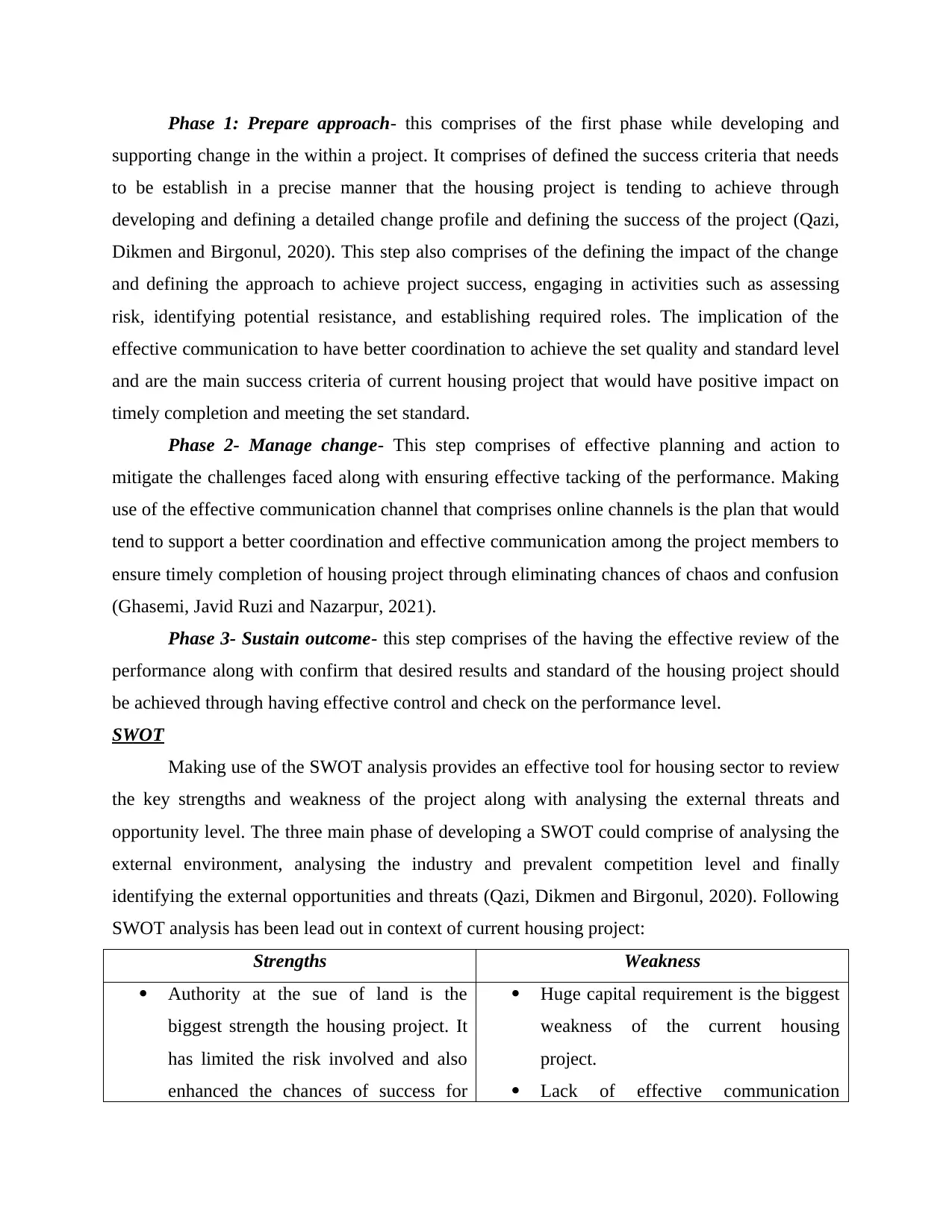
Phase 1: Prepare approach- this comprises of the first phase while developing and
supporting change in the within a project. It comprises of defined the success criteria that needs
to be establish in a precise manner that the housing project is tending to achieve through
developing and defining a detailed change profile and defining the success of the project (Qazi,
Dikmen and Birgonul, 2020). This step also comprises of the defining the impact of the change
and defining the approach to achieve project success, engaging in activities such as assessing
risk, identifying potential resistance, and establishing required roles. The implication of the
effective communication to have better coordination to achieve the set quality and standard level
and are the main success criteria of current housing project that would have positive impact on
timely completion and meeting the set standard.
Phase 2- Manage change- This step comprises of effective planning and action to
mitigate the challenges faced along with ensuring effective tacking of the performance. Making
use of the effective communication channel that comprises online channels is the plan that would
tend to support a better coordination and effective communication among the project members to
ensure timely completion of housing project through eliminating chances of chaos and confusion
(Ghasemi, Javid Ruzi and Nazarpur, 2021).
Phase 3- Sustain outcome- this step comprises of the having the effective review of the
performance along with confirm that desired results and standard of the housing project should
be achieved through having effective control and check on the performance level.
SWOT
Making use of the SWOT analysis provides an effective tool for housing sector to review
the key strengths and weakness of the project along with analysing the external threats and
opportunity level. The three main phase of developing a SWOT could comprise of analysing the
external environment, analysing the industry and prevalent competition level and finally
identifying the external opportunities and threats (Qazi, Dikmen and Birgonul, 2020). Following
SWOT analysis has been lead out in context of current housing project:
Strengths Weakness
Authority at the sue of land is the
biggest strength the housing project. It
has limited the risk involved and also
enhanced the chances of success for
Huge capital requirement is the biggest
weakness of the current housing
project.
Lack of effective communication
supporting change in the within a project. It comprises of defined the success criteria that needs
to be establish in a precise manner that the housing project is tending to achieve through
developing and defining a detailed change profile and defining the success of the project (Qazi,
Dikmen and Birgonul, 2020). This step also comprises of the defining the impact of the change
and defining the approach to achieve project success, engaging in activities such as assessing
risk, identifying potential resistance, and establishing required roles. The implication of the
effective communication to have better coordination to achieve the set quality and standard level
and are the main success criteria of current housing project that would have positive impact on
timely completion and meeting the set standard.
Phase 2- Manage change- This step comprises of effective planning and action to
mitigate the challenges faced along with ensuring effective tacking of the performance. Making
use of the effective communication channel that comprises online channels is the plan that would
tend to support a better coordination and effective communication among the project members to
ensure timely completion of housing project through eliminating chances of chaos and confusion
(Ghasemi, Javid Ruzi and Nazarpur, 2021).
Phase 3- Sustain outcome- this step comprises of the having the effective review of the
performance along with confirm that desired results and standard of the housing project should
be achieved through having effective control and check on the performance level.
SWOT
Making use of the SWOT analysis provides an effective tool for housing sector to review
the key strengths and weakness of the project along with analysing the external threats and
opportunity level. The three main phase of developing a SWOT could comprise of analysing the
external environment, analysing the industry and prevalent competition level and finally
identifying the external opportunities and threats (Qazi, Dikmen and Birgonul, 2020). Following
SWOT analysis has been lead out in context of current housing project:
Strengths Weakness
Authority at the sue of land is the
biggest strength the housing project. It
has limited the risk involved and also
enhanced the chances of success for
Huge capital requirement is the biggest
weakness of the current housing
project.
Lack of effective communication
Paraphrase This Document
Need a fresh take? Get an instant paraphrase of this document with our AI Paraphraser
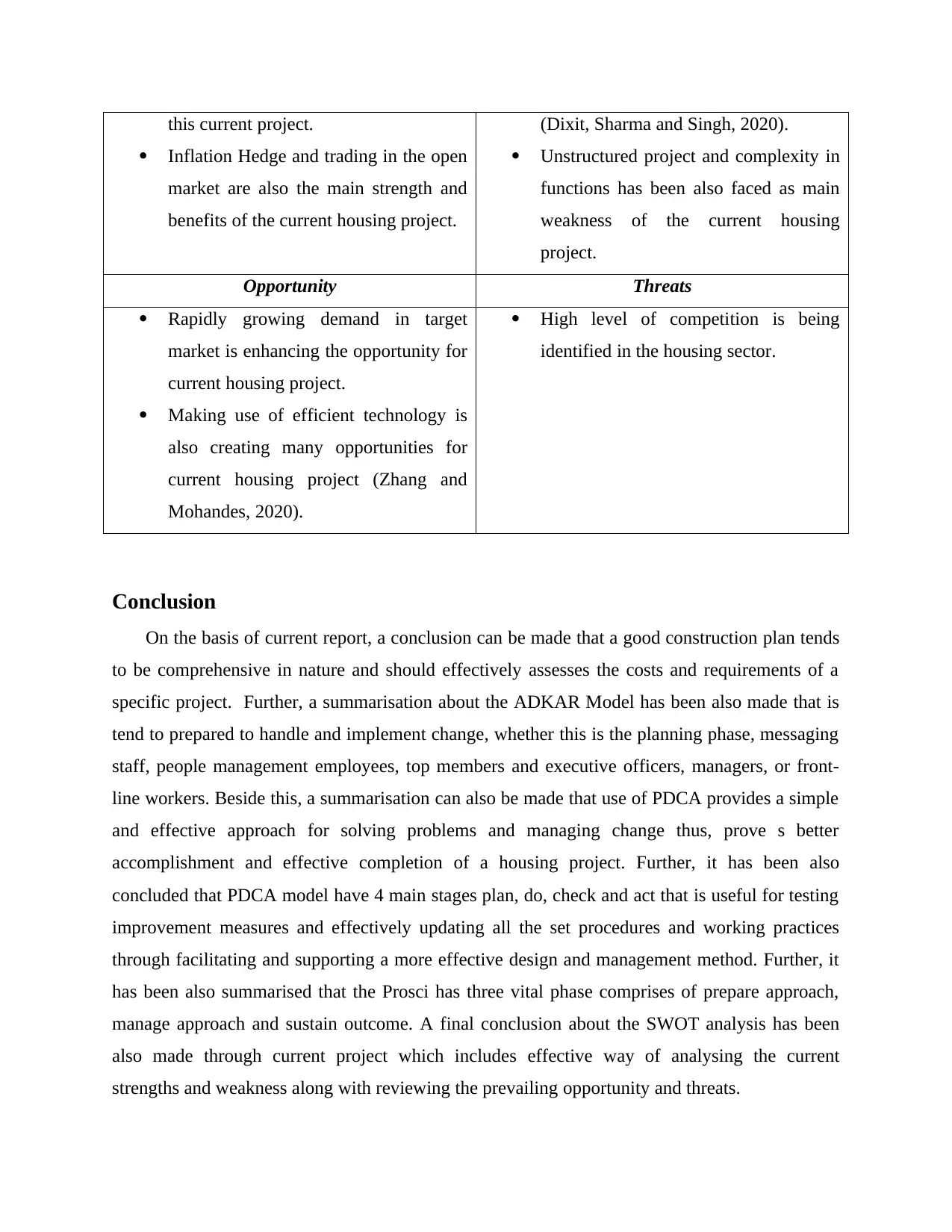
this current project.
Inflation Hedge and trading in the open
market are also the main strength and
benefits of the current housing project.
(Dixit, Sharma and Singh, 2020).
Unstructured project and complexity in
functions has been also faced as main
weakness of the current housing
project.
Opportunity Threats
Rapidly growing demand in target
market is enhancing the opportunity for
current housing project.
Making use of efficient technology is
also creating many opportunities for
current housing project (Zhang and
Mohandes, 2020).
High level of competition is being
identified in the housing sector.
Conclusion
On the basis of current report, a conclusion can be made that a good construction plan tends
to be comprehensive in nature and should effectively assesses the costs and requirements of a
specific project. Further, a summarisation about the ADKAR Model has been also made that is
tend to prepared to handle and implement change, whether this is the planning phase, messaging
staff, people management employees, top members and executive officers, managers, or front-
line workers. Beside this, a summarisation can also be made that use of PDCA provides a simple
and effective approach for solving problems and managing change thus, prove s better
accomplishment and effective completion of a housing project. Further, it has been also
concluded that PDCA model have 4 main stages plan, do, check and act that is useful for testing
improvement measures and effectively updating all the set procedures and working practices
through facilitating and supporting a more effective design and management method. Further, it
has been also summarised that the Prosci has three vital phase comprises of prepare approach,
manage approach and sustain outcome. A final conclusion about the SWOT analysis has been
also made through current project which includes effective way of analysing the current
strengths and weakness along with reviewing the prevailing opportunity and threats.
Inflation Hedge and trading in the open
market are also the main strength and
benefits of the current housing project.
(Dixit, Sharma and Singh, 2020).
Unstructured project and complexity in
functions has been also faced as main
weakness of the current housing
project.
Opportunity Threats
Rapidly growing demand in target
market is enhancing the opportunity for
current housing project.
Making use of efficient technology is
also creating many opportunities for
current housing project (Zhang and
Mohandes, 2020).
High level of competition is being
identified in the housing sector.
Conclusion
On the basis of current report, a conclusion can be made that a good construction plan tends
to be comprehensive in nature and should effectively assesses the costs and requirements of a
specific project. Further, a summarisation about the ADKAR Model has been also made that is
tend to prepared to handle and implement change, whether this is the planning phase, messaging
staff, people management employees, top members and executive officers, managers, or front-
line workers. Beside this, a summarisation can also be made that use of PDCA provides a simple
and effective approach for solving problems and managing change thus, prove s better
accomplishment and effective completion of a housing project. Further, it has been also
concluded that PDCA model have 4 main stages plan, do, check and act that is useful for testing
improvement measures and effectively updating all the set procedures and working practices
through facilitating and supporting a more effective design and management method. Further, it
has been also summarised that the Prosci has three vital phase comprises of prepare approach,
manage approach and sustain outcome. A final conclusion about the SWOT analysis has been
also made through current project which includes effective way of analysing the current
strengths and weakness along with reviewing the prevailing opportunity and threats.
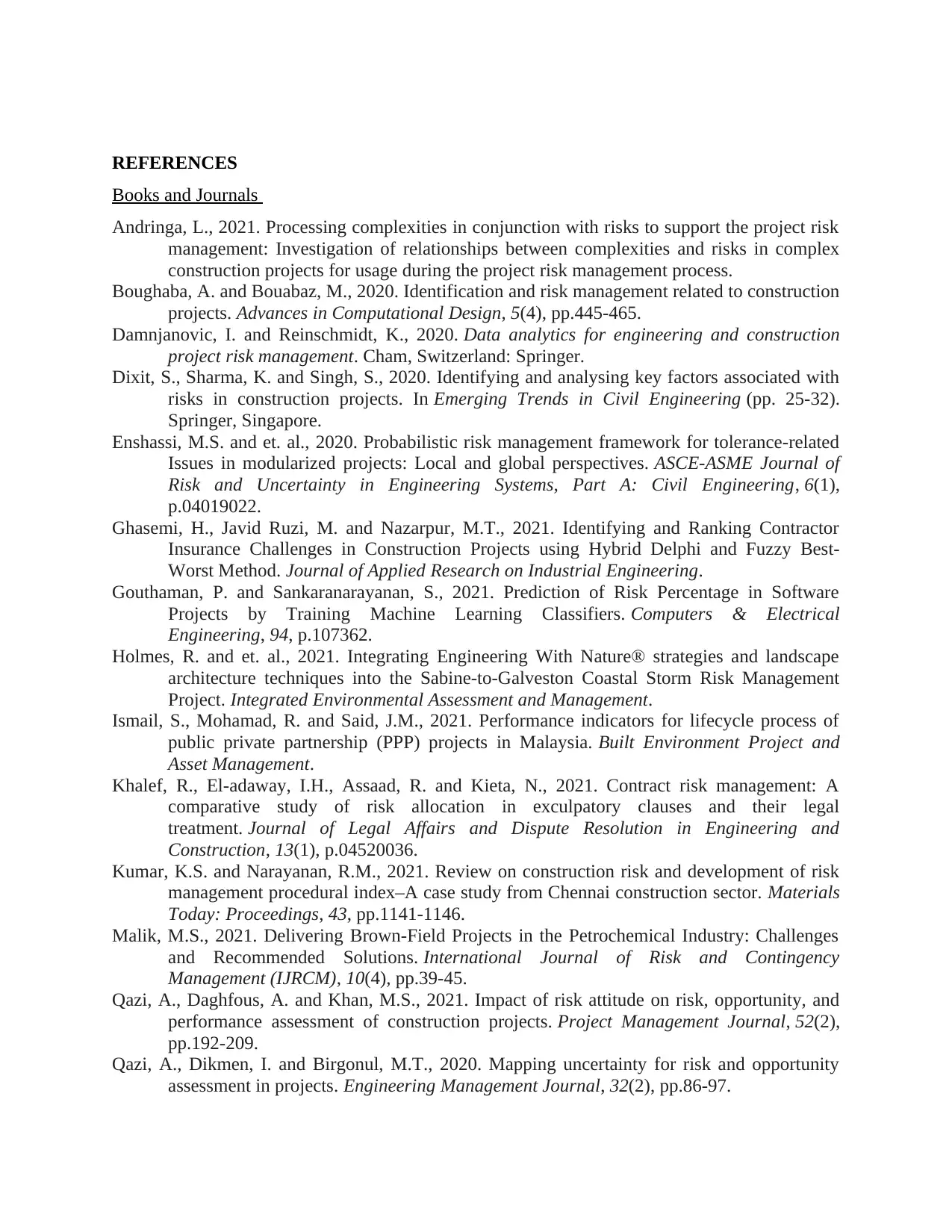
REFERENCES
Books and Journals
Andringa, L., 2021. Processing complexities in conjunction with risks to support the project risk
management: Investigation of relationships between complexities and risks in complex
construction projects for usage during the project risk management process.
Boughaba, A. and Bouabaz, M., 2020. Identification and risk management related to construction
projects. Advances in Computational Design, 5(4), pp.445-465.
Damnjanovic, I. and Reinschmidt, K., 2020. Data analytics for engineering and construction
project risk management. Cham, Switzerland: Springer.
Dixit, S., Sharma, K. and Singh, S., 2020. Identifying and analysing key factors associated with
risks in construction projects. In Emerging Trends in Civil Engineering (pp. 25-32).
Springer, Singapore.
Enshassi, M.S. and et. al., 2020. Probabilistic risk management framework for tolerance-related
Issues in modularized projects: Local and global perspectives. ASCE-ASME Journal of
Risk and Uncertainty in Engineering Systems, Part A: Civil Engineering, 6(1),
p.04019022.
Ghasemi, H., Javid Ruzi, M. and Nazarpur, M.T., 2021. Identifying and Ranking Contractor
Insurance Challenges in Construction Projects using Hybrid Delphi and Fuzzy Best-
Worst Method. Journal of Applied Research on Industrial Engineering.
Gouthaman, P. and Sankaranarayanan, S., 2021. Prediction of Risk Percentage in Software
Projects by Training Machine Learning Classifiers. Computers & Electrical
Engineering, 94, p.107362.
Holmes, R. and et. al., 2021. Integrating Engineering With Nature® strategies and landscape
architecture techniques into the Sabine‐to‐Galveston Coastal Storm Risk Management
Project. Integrated Environmental Assessment and Management.
Ismail, S., Mohamad, R. and Said, J.M., 2021. Performance indicators for lifecycle process of
public private partnership (PPP) projects in Malaysia. Built Environment Project and
Asset Management.
Khalef, R., El-adaway, I.H., Assaad, R. and Kieta, N., 2021. Contract risk management: A
comparative study of risk allocation in exculpatory clauses and their legal
treatment. Journal of Legal Affairs and Dispute Resolution in Engineering and
Construction, 13(1), p.04520036.
Kumar, K.S. and Narayanan, R.M., 2021. Review on construction risk and development of risk
management procedural index–A case study from Chennai construction sector. Materials
Today: Proceedings, 43, pp.1141-1146.
Malik, M.S., 2021. Delivering Brown-Field Projects in the Petrochemical Industry: Challenges
and Recommended Solutions. International Journal of Risk and Contingency
Management (IJRCM), 10(4), pp.39-45.
Qazi, A., Daghfous, A. and Khan, M.S., 2021. Impact of risk attitude on risk, opportunity, and
performance assessment of construction projects. Project Management Journal, 52(2),
pp.192-209.
Qazi, A., Dikmen, I. and Birgonul, M.T., 2020. Mapping uncertainty for risk and opportunity
assessment in projects. Engineering Management Journal, 32(2), pp.86-97.
Books and Journals
Andringa, L., 2021. Processing complexities in conjunction with risks to support the project risk
management: Investigation of relationships between complexities and risks in complex
construction projects for usage during the project risk management process.
Boughaba, A. and Bouabaz, M., 2020. Identification and risk management related to construction
projects. Advances in Computational Design, 5(4), pp.445-465.
Damnjanovic, I. and Reinschmidt, K., 2020. Data analytics for engineering and construction
project risk management. Cham, Switzerland: Springer.
Dixit, S., Sharma, K. and Singh, S., 2020. Identifying and analysing key factors associated with
risks in construction projects. In Emerging Trends in Civil Engineering (pp. 25-32).
Springer, Singapore.
Enshassi, M.S. and et. al., 2020. Probabilistic risk management framework for tolerance-related
Issues in modularized projects: Local and global perspectives. ASCE-ASME Journal of
Risk and Uncertainty in Engineering Systems, Part A: Civil Engineering, 6(1),
p.04019022.
Ghasemi, H., Javid Ruzi, M. and Nazarpur, M.T., 2021. Identifying and Ranking Contractor
Insurance Challenges in Construction Projects using Hybrid Delphi and Fuzzy Best-
Worst Method. Journal of Applied Research on Industrial Engineering.
Gouthaman, P. and Sankaranarayanan, S., 2021. Prediction of Risk Percentage in Software
Projects by Training Machine Learning Classifiers. Computers & Electrical
Engineering, 94, p.107362.
Holmes, R. and et. al., 2021. Integrating Engineering With Nature® strategies and landscape
architecture techniques into the Sabine‐to‐Galveston Coastal Storm Risk Management
Project. Integrated Environmental Assessment and Management.
Ismail, S., Mohamad, R. and Said, J.M., 2021. Performance indicators for lifecycle process of
public private partnership (PPP) projects in Malaysia. Built Environment Project and
Asset Management.
Khalef, R., El-adaway, I.H., Assaad, R. and Kieta, N., 2021. Contract risk management: A
comparative study of risk allocation in exculpatory clauses and their legal
treatment. Journal of Legal Affairs and Dispute Resolution in Engineering and
Construction, 13(1), p.04520036.
Kumar, K.S. and Narayanan, R.M., 2021. Review on construction risk and development of risk
management procedural index–A case study from Chennai construction sector. Materials
Today: Proceedings, 43, pp.1141-1146.
Malik, M.S., 2021. Delivering Brown-Field Projects in the Petrochemical Industry: Challenges
and Recommended Solutions. International Journal of Risk and Contingency
Management (IJRCM), 10(4), pp.39-45.
Qazi, A., Daghfous, A. and Khan, M.S., 2021. Impact of risk attitude on risk, opportunity, and
performance assessment of construction projects. Project Management Journal, 52(2),
pp.192-209.
Qazi, A., Dikmen, I. and Birgonul, M.T., 2020. Mapping uncertainty for risk and opportunity
assessment in projects. Engineering Management Journal, 32(2), pp.86-97.
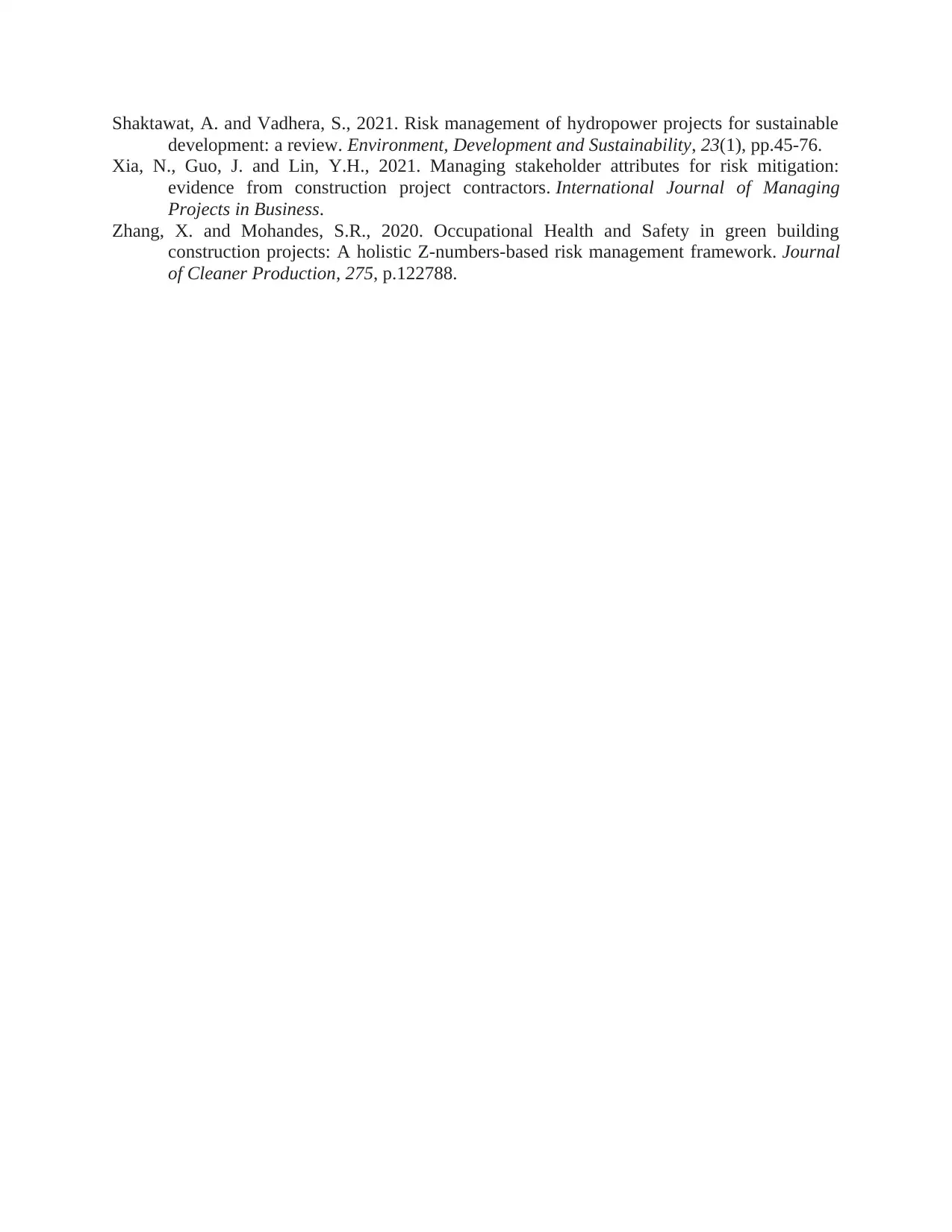
Shaktawat, A. and Vadhera, S., 2021. Risk management of hydropower projects for sustainable
development: a review. Environment, Development and Sustainability, 23(1), pp.45-76.
Xia, N., Guo, J. and Lin, Y.H., 2021. Managing stakeholder attributes for risk mitigation:
evidence from construction project contractors. International Journal of Managing
Projects in Business.
Zhang, X. and Mohandes, S.R., 2020. Occupational Health and Safety in green building
construction projects: A holistic Z-numbers-based risk management framework. Journal
of Cleaner Production, 275, p.122788.
development: a review. Environment, Development and Sustainability, 23(1), pp.45-76.
Xia, N., Guo, J. and Lin, Y.H., 2021. Managing stakeholder attributes for risk mitigation:
evidence from construction project contractors. International Journal of Managing
Projects in Business.
Zhang, X. and Mohandes, S.R., 2020. Occupational Health and Safety in green building
construction projects: A holistic Z-numbers-based risk management framework. Journal
of Cleaner Production, 275, p.122788.
1 out of 16
Related Documents
Your All-in-One AI-Powered Toolkit for Academic Success.
+13062052269
info@desklib.com
Available 24*7 on WhatsApp / Email
![[object Object]](/_next/static/media/star-bottom.7253800d.svg)
Unlock your academic potential
© 2024 | Zucol Services PVT LTD | All rights reserved.




